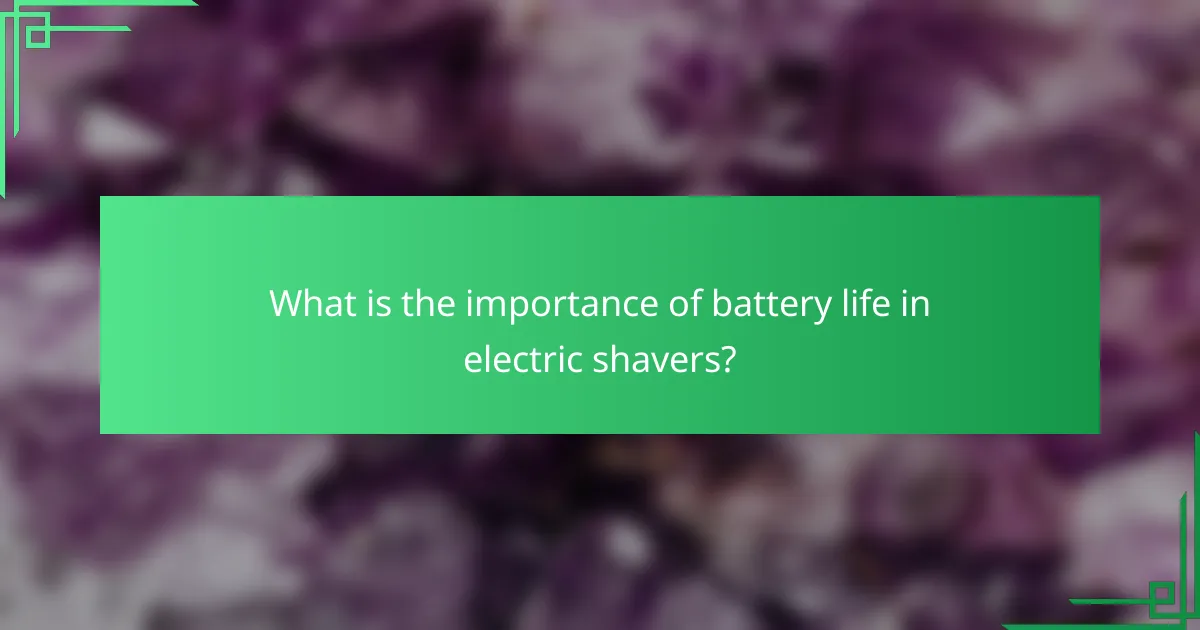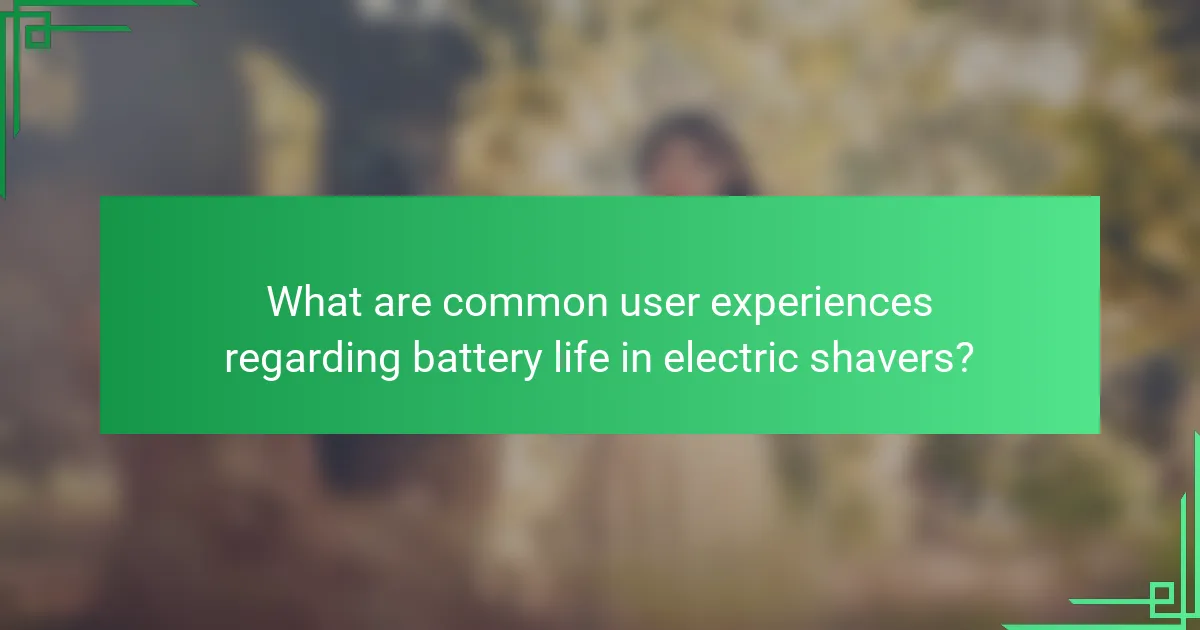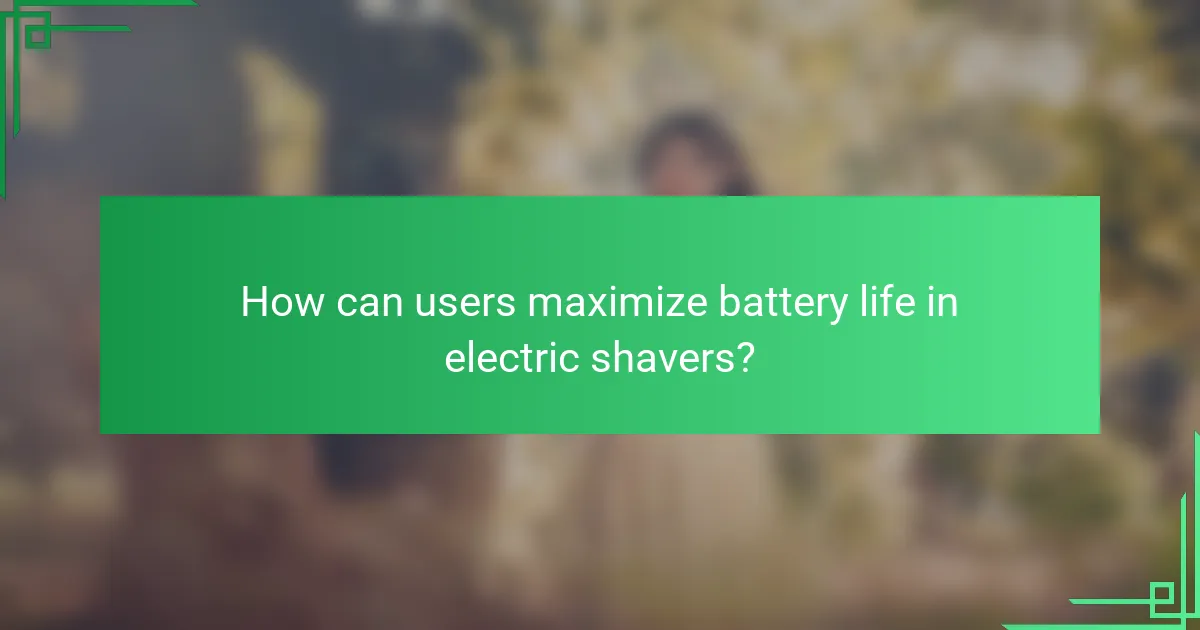Battery life is a critical factor in the performance and user satisfaction of electric shavers. This article evaluates user experiences and reviews related to battery longevity, highlighting the importance of extended usage without frequent recharging, especially for travelers and busy individuals. It discusses common user feedback on battery performance, including satisfaction with models that provide 60 to 90 minutes of use per charge and features like quick charging. Additionally, the article outlines best practices for maximizing battery life, such as regular cleaning, avoiding overcharging, and using recommended settings. Overall, the discussion emphasizes the significant impact of battery life on the functionality and convenience of electric shavers.

What is the importance of battery life in electric shavers?
Battery life in electric shavers is crucial for user convenience and efficiency. A longer battery life allows for extended usage without frequent recharging. This is particularly important for travelers or individuals with busy schedules. Electric shavers with poor battery life may lead to interruptions during grooming routines. Many users prefer shavers that can provide multiple shaves on a single charge. For instance, some high-end models offer battery lives of up to 60 minutes. This ensures that users can complete their grooming without worrying about battery depletion. Furthermore, shavers with quick charge features enhance usability for those in a hurry. Overall, battery life significantly impacts user satisfaction and product functionality.
How does battery life impact user experience with electric shavers?
Battery life significantly impacts user experience with electric shavers. A longer battery life allows for more extended use without needing a recharge. Users can complete their grooming routines uninterrupted, which enhances convenience. Conversely, shorter battery life can lead to frustration, especially if the shaver dies mid-use. This can disrupt the grooming process and necessitate waiting for a recharge. The average battery life for electric shavers ranges from 30 minutes to over an hour. Users often prefer models that offer quick charging options for added flexibility. Reliable battery performance is crucial for maintaining user satisfaction and loyalty.
What are the typical battery life expectations for electric shavers?
Typical battery life expectations for electric shavers range from 40 to 90 minutes of use per charge. Most electric shavers require about one to two hours to fully charge. High-end models may offer longer battery life, reaching up to 120 minutes. Users often report that battery performance decreases after several years of use. Additionally, some shavers feature quick-charge options, providing enough power for a single shave in just a few minutes. Battery life can vary based on usage frequency and shaving technique. Regular maintenance, such as cleaning and oiling, can help prolong battery performance.
How does battery life influence the overall performance of electric shavers?
Battery life directly impacts the overall performance of electric shavers. A longer battery life allows for extended use without interruptions. This ensures that users can complete their shaving routine efficiently. Conversely, a short battery life may lead to incomplete shaves and increased downtime for recharging. Many electric shavers offer a runtime of 40 to 60 minutes on a full charge. Users often report frustration when the shaver runs out of power mid-use. Therefore, battery capacity is crucial for consistent performance and user satisfaction.
What factors contribute to battery life in electric shavers?
Battery life in electric shavers is influenced by several factors. The capacity of the battery, measured in milliampere-hours (mAh), directly affects how long the shaver can operate before needing a recharge. The efficiency of the motor also plays a crucial role; a more efficient motor consumes less power, extending battery life. Additionally, the type of battery technology used, such as lithium-ion versus nickel-cadmium, impacts longevity and charging cycles.
The design of the shaver, including its weight and aerodynamics, can affect energy consumption. Regular maintenance, such as cleaning the blades, can enhance performance and battery efficiency. The frequency and duration of use are important; more frequent use drains the battery faster. Lastly, the charging habits of the user, including overcharging or allowing the battery to fully discharge, can influence the overall lifespan of the battery.
How do battery types affect the longevity of electric shavers?
Battery types significantly influence the longevity of electric shavers. Lithium-ion batteries typically last longer than nickel-cadmium batteries. Lithium-ion batteries have a higher energy density, allowing for extended usage between charges. They also have a lower self-discharge rate, retaining charge longer when not in use. In contrast, nickel-cadmium batteries suffer from memory effect, reducing their effective capacity over time. Studies show that lithium-ion batteries can provide up to 1000 charge cycles, while nickel-cadmium batteries may only last for about 500 cycles. This leads to a longer lifespan for electric shavers powered by lithium-ion technology. Therefore, the choice of battery type directly impacts the overall durability and longevity of the device.
What role does charging time play in battery life evaluation?
Charging time significantly influences battery life evaluation. Shorter charging times can enhance user convenience and satisfaction. However, rapid charging may lead to increased heat generation. Excessive heat can degrade battery health over time. Conversely, longer charging times often allow for more thorough battery conditioning. This can improve overall battery longevity. Studies indicate that batteries charged slowly tend to have a longer lifespan. Therefore, the balance between charging time and battery health is crucial for optimal performance.

What are common user experiences regarding battery life in electric shavers?
Common user experiences regarding battery life in electric shavers vary widely. Many users report satisfaction with the longevity of their shaver’s battery. They often mention being able to complete multiple shaves on a single charge. Some models provide 60 to 90 minutes of use per charge. Users appreciate quick charging features that allow for a full charge in under an hour. However, some users express frustration with batteries degrading over time. Reports indicate that after several months, some shavers may require more frequent charging. Users also note that heavy usage can significantly impact battery life. Overall, experiences highlight a mix of satisfaction and concerns about battery longevity and performance.
How do users generally rate battery life across different brands?
Users generally rate battery life in electric shavers based on performance and longevity. Brands like Philips and Braun often receive high ratings for their battery efficiency. Users report that Philips shavers can last up to 60 minutes on a single charge. Braun shavers also receive praise, with many models providing 50-60 minutes of use. In contrast, some lesser-known brands may have shorter battery life, averaging around 30-40 minutes. User reviews frequently highlight the importance of quick charging features. Overall, battery life ratings vary by brand, with established names leading in user satisfaction.
What specific features do users appreciate in electric shaver batteries?
Users appreciate long battery life in electric shaver batteries. A longer battery life allows for multiple uses without frequent recharging. Quick charging capabilities are also valued by users. Many prefer batteries that can fully charge in under an hour. Users often look for indicators that show battery level. This feature helps them know when to recharge. Durability and longevity of the battery are important as well. Users appreciate batteries that maintain performance over time. Finally, lightweight batteries enhance the overall usability of the shaver.
What complaints do users commonly have about battery life?
Users commonly complain about short battery life in electric shavers. Many users report that their shavers do not last long enough for multiple uses. Some find that the battery drains quickly during a single shave. Others express frustration over the time required for recharging. Users also mention that battery performance degrades over time. A significant number indicate that the battery life does not meet advertised expectations. Additionally, some users experience inconsistent performance due to battery issues. These complaints highlight the importance of reliable battery life in electric shavers.
What are the differences in battery performance among popular electric shaver models?
The battery performance among popular electric shaver models varies significantly. Some models offer up to 60 minutes of shaving time on a full charge. Others may provide only 30 minutes before needing a recharge. The charging time also differs; some shavers fully charge in one hour, while others take up to two hours.
For example, the Philips Norelco 9000 series can offer 60 minutes of usage after one hour of charging. In contrast, the Braun Series 9 provides similar usage but requires two hours to charge fully. Additionally, certain models, like the Panasonic Arc5, feature a quick charge option, providing enough power for a single shave in just five minutes.
Battery longevity is another factor; some models maintain performance for several years, while others may degrade faster. Overall, the differences in battery performance among electric shavers can affect user experience and satisfaction.
Which electric shaver models are known for exceptional battery life?
The electric shaver models known for exceptional battery life include the Braun Series 9, Philips Norelco 9000 Series, and Panasonic Arc5. The Braun Series 9 offers up to 60 minutes of cordless shaving on a full charge. Users frequently report that it charges quickly, often in about one hour. The Philips Norelco 9000 Series can provide up to 120 minutes of use after a one-hour charge. This model features a powerful lithium-ion battery. The Panasonic Arc5 also delivers impressive battery life, with approximately 45 minutes of shaving time per charge. It includes a fast-charging feature that allows for quick use. These models consistently receive positive reviews for their battery performance from users.
How do budget electric shavers compare to premium models in terms of battery life?
Budget electric shavers typically have shorter battery life compared to premium models. Budget models often feature batteries with a capacity of around 30 to 60 minutes of usage per charge. In contrast, premium electric shavers can provide 60 to 120 minutes of usage on a full charge. Furthermore, premium shavers often include advanced battery technology, such as lithium-ion batteries, which enhance performance and longevity. Many premium models also offer quick charge options, allowing for a full shave in just a few minutes of charging. This difference in battery life can significantly impact user experience, especially for those who shave frequently.

How can users maximize battery life in electric shavers?
To maximize battery life in electric shavers, users should follow several practices. First, regularly clean the shaver to ensure optimal performance. Dirt and hair can strain the motor, leading to faster battery depletion. Second, avoid overcharging the battery. Overcharging can reduce battery lifespan significantly. Third, store the shaver in a cool, dry place. Extreme temperatures can negatively impact battery health. Fourth, use the shaver on the recommended settings. Higher power settings consume more battery. Fifth, replace worn blades promptly. Dull blades require more power to operate effectively. Lastly, charge the battery only when necessary. Frequent partial charges can diminish battery capacity over time. Following these guidelines can enhance battery longevity in electric shavers.
What best practices should users follow for maintaining battery health?
To maintain battery health, users should follow specific best practices. Regularly charging the battery to around 50% is recommended. Avoid letting the battery drain completely before recharging. Keeping the battery at moderate temperatures enhances longevity. High heat can damage battery cells, reducing their lifespan. Using the correct charger for the device is crucial. Mismatched chargers can cause overheating and inefficiency. Additionally, storing the device with a partially charged battery is advised for long periods of inactivity. This practice helps prevent deep discharge. Following these guidelines can significantly extend the battery’s overall health and performance.
How often should users charge their electric shavers for optimal battery life?
Users should charge their electric shavers after every use for optimal battery life. This practice ensures that the battery remains healthy and extends its overall lifespan. Regular charging prevents the battery from fully depleting, which can lead to reduced performance over time. Most electric shavers are designed to handle frequent charging without damage. Additionally, charging after each use helps maintain consistent power levels for effective shaving. Following the manufacturer’s guidelines can further enhance battery longevity.
What signs indicate that an electric shaver’s battery needs replacement?
Signs that indicate an electric shaver’s battery needs replacement include diminished runtime and slow charging. If the shaver runs for significantly less time than when new, it suggests battery wear. A shaver that takes longer to charge than it used to may also signal battery degradation. Additionally, if the device frequently shuts off during use, it indicates insufficient power. Lastly, a swollen or damaged battery casing is a clear sign that replacement is necessary. These signs are commonly reported by users experiencing battery issues in electric shavers.
What troubleshooting tips can help users with battery-related issues in electric shavers?
Check the battery contacts for corrosion or dirt. Clean them with a soft cloth and isopropyl alcohol. Ensure the battery is properly seated in its compartment. If the battery is removable, try reinserting it. Charge the shaver for the recommended time as per the manufacturer’s instructions. If it still does not work, test the charger with another device to confirm its functionality. Replace the battery if it is old or shows signs of swelling. Consult the user manual for specific troubleshooting steps related to your model.
How can users identify and resolve common battery problems?
Users can identify common battery problems by observing signs such as rapid discharging, overheating, or failure to charge. To resolve these issues, users should first inspect the battery for physical damage or corrosion. Cleaning the battery contacts can improve connectivity and charging efficiency. If the battery is removable, users can try replacing it with a new one. For built-in batteries, resetting the device may help. Users should also ensure they are using the correct charger. Regular maintenance, such as avoiding extreme temperatures, can prolong battery life. These steps are supported by common troubleshooting practices in electronic devices.
What resources are available for users experiencing battery issues with their electric shavers?
Users experiencing battery issues with their electric shavers can access several resources. Manufacturer websites often provide troubleshooting guides and FAQs. Online forums and communities allow users to share experiences and solutions. Instruction manuals typically include battery care tips and maintenance advice. Customer service hotlines offer direct assistance for specific problems. YouTube channels may feature video tutorials on battery replacement. Retailer websites frequently have customer reviews discussing battery performance. Warranty information can guide users on repair or replacement options.
The main entity of this article is battery life in electric shavers. The article evaluates the importance of battery life for user convenience and satisfaction, detailing typical expectations, factors influencing battery performance, and user experiences across various brands. It discusses how battery type, charging time, and maintenance practices affect longevity and overall performance. Additionally, the article highlights common user complaints and offers troubleshooting tips for addressing battery-related issues, ensuring readers gain a comprehensive understanding of battery life in electric shavers.